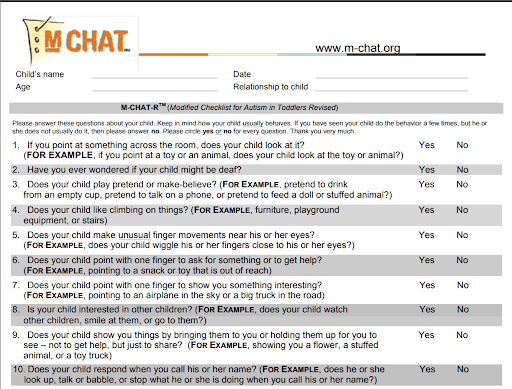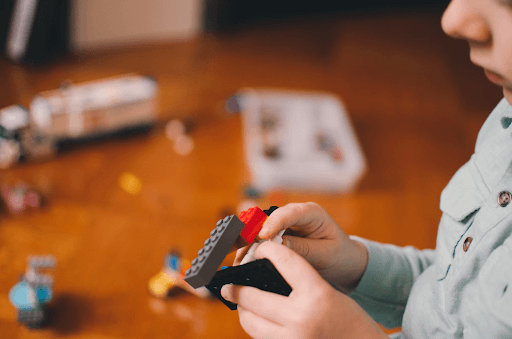Autism Screening and Evaluation: The Complete Guide for Parents

Your parent intuition has served you well in the past, but you have a feeling that something might be a little “off” with your child.
In fact, you’re starting to wonder if your little one’s behavior is a cause for concern.
You’ve heard about autism from your family and friends, but, to be honest, you’re not completely sure what that word even means.
This is a common progression of thoughts for many parents of young children.
According to the CDC, 1 in 59 children will be diagnosed with autism this year1.
But what do those numbers actually mean for you and your family?
What are some steps you can take if you are concerned your child might have autism?
You’ve absolutely come to the right place.
We’re here to break down the autism screening and evaluation processes so that you know what to expect–and what to ask–if and when you decide to get your child checked out.
Here’s what we’ll cover in this post:
2. We’ll review the most common autism screening tools.
3. We’ll show you the timeline that pediatricians follow when conducting routine autism screening for toddlers.
4. We will then walk you through the autism-evaluation process.
5. Like the autism-screening process, the autism-evaluation process has its own set of commonly used evaluation tools. We’ll talk about these in detail so that you know what to expect.
But before we begin, let’s set the record straight.
Screening for autism is not the same thing as evaluating for autism.
The first one is used by healthcare professionals to quickly check for signs of autism spectrum disorder, and the second is a longer process that is used to verify a diagnosis of autism and confirm the types of supports that might be needed.
Here’s something important to remember:
If you are concerned that your child might be on the autism spectrum, it is better to act sooner rather than later. This is especially the case if there is a history of autism diagnoses within your family.
Early intervention absolutely leads to better outcomes in the long-term for individuals living with autism2.
So what is autism screening? And what do you need to know about it?
First of all, your child will not be screened for autism right away, and here’s why.
It tends to take about one and a half to two years for symptoms of autism to become prominent enough that they can be accurately identified.
This is the screening schedule recommended by the American Academy of Pediatrics3:
9 Months: Screening for Developmental Delays
18 Months: Screening for Signs of Autism Spectrum Disorder
24 Months: Another Screening for Signs of Autism Spectrum Disorder
Let’s move on now to the autism screening tools that your family pediatrician will use to initially assess your child.
The most common autism screening tool is the Modified Checklist for Autism in Toddlers(M-CHAT)
That’s quite a mouthful, so you’ll most likely hear it being mentioned by its other name, the M-CHAT.

Source: https://cms.m-chat.org/LineagenMChat/media/Lineagen-M-Chat-Media/mchatDOTorg.pdf
Remember, screening is not diagnosing; it’s just the first step.
The second step in this process is a formal autism evaluation.
If your child is screened, and it is indicated that they might have autism, this is what needs to happen next.
The Autism Evaluation Process
These are the three types of health care providers who can complete a formal evaluation:
- A developmental pediatrician
- A child psychiatrist
- A child neurologist
Any of these providers have the power to provide an official evaluation and diagnosis.
Now that you know titles and roles of the autism professionals who can evaluate children for signs of autism, let’s go over what the autism-evaluation process itself looks like.
The most likely focus of the autism evaluation process will be on the Autism Diagnostic Observation Schedule, also known as the ADOS. The ADOS-2, which is an updated version of the original diagnostic tool, may also be used.
The ADOS is frequently paired with the ADI, which stands for Autism Diagnostic Interview.
We realize this might be getting to the point of acronym overload, so we’ll spend some time to pick apart the differences between all of these letters.
Autism Diagnostic Observation Schedule (ADOS):
The ADOS is currently recognized as the gold standard in autism diagnosis tools.
That is because it allows for standardized measurement while a child participates in an assortment of both structured and semi-structured tasks.
The entire process is multi-faceted and consists of gauging a child’s social skills and any behaviors that may be indicative of autism spectrum disorder as it’s described in the most recent version of the Diagnostic and Statistical Manual, or the DSM-5.
The DSM-5 is the book that mental-health professionals refer to in the United States when deciding on one diagnosis versus another.
A qualified clinician selects a diagnosis based on the guidance in this manual.
But where does the ADOS fit in with all of this?
The ADOS is simply one tool among many that trained professionals can use to collect evidence to build a case for a diagnosis of autism spectrum disorder.

In addition, clinicians facilitating the ADOS testing process can choose from one of four ADOS modules.
The four modules align with various stages of child development. As such, they can be used to assess the full range of a child’s possible developmental stages, from children who are not yet speaking to children who have solid verbal skills, from children who are not yet playing with toys to children who are–or, are already past the stage of playing with toys.
Ultimately, the ADOS is only one piece of the puzzle, and it is often completed alongside another assessment tool, which we will review next.
Autism Diagnostic Interview (ADI):
The Autism Diagnostic Interview is a diagnostic tool used in conjunction with the ADOS.
You, as the parent or primary caregiver, will provide answers to questions that the interviewing clinician will then use to compile a more complete understanding of how your child typical behavior.
Finally, your child’s pediatrician will also likely refer your child for cognitive testing as part of a complete, well-rounded assessment.
We’ve covered a lot of ground in this post.
We hope you found this to be a helpful introduction to the important information you need to know as you deal with autism screening and, potentially, getting a professional autism evaluation should a screening indicate it is warranted.
If you’re interested in learning about common autism-treatment options, we covered the major categories of applied behavior analysis in this post.
Education is the first step. Using that education to ask the right questions so that your child has the best possible autism support is what comes next.
Let’s be honest: it can be really overwhelming to have to do all of this on your own.
That’s why we created the AnswersNow app–to match caregivers with trained autism clinicians in a simple, convenient way.
Some of the most frustrating and confusing moments for parents are the first few days after an autism diagnosis.
They ask medical professionals: What do I do next?
And, more often than not, they get a list of “providers” and maybe a list of local resources.
Yes, it’s important to contact those resources and get help, whether that is getting your child into a specialized school, having providers come to your home, or finding a clinic nearby.
But the truth is that you are, and always will be, the most important person in your child’s support team.
So it’s crucial that you know as much as possible–and that you feel competent and supported.
When we first learned about how effective we can be “bending the curve” of autism, we also learned that parent involvement is critical to long-term success.
This is where AnswersNow comes in.
Our goal is to not only answer your questions about autism but to empower you to have the skills to understand your child’s behaviors. We also help you develop an action plan for any situation and help you work seamlessly with specialists to support your child as much as possible.
What are we specifically talking about? To start, your AnswersNow clinician can help you with all of the following scenarios:
2. Manage/improve challenging behaviors
3. Make outings less challenging
4. Improve your child’s social skills
5. Help your child learn how to take care of themselves (life skills)
These are just a few of the ways we can help.
We know that caregivers don’t receive this kind of training and often don’t get the resources they need–or have a trusted support system they can turn to–when they have questions about parenting a child on the autism spectrum.
All of our AnswersNow clinicians have at least a master’s degree and are board-certified in behavior analysis.
Parents and grandparents use the app daily to get answers to all of their autism-parenting questions. Additionally, adults with autism also use the app to get answers to questions they have about their own experiences living on the spectrum.
If you feel like you could use some extra assistance in navigating the world of autism parenting, we are here to help.
Click here to learn how our process works or click one of the download buttons below to start getting answers from your personal autism expert today!
Sources:
1 = https://www.cdc.gov/ncbddd/autism/data.html
3 = https://pediatrics.aappublications.org/content/120/5/1183

